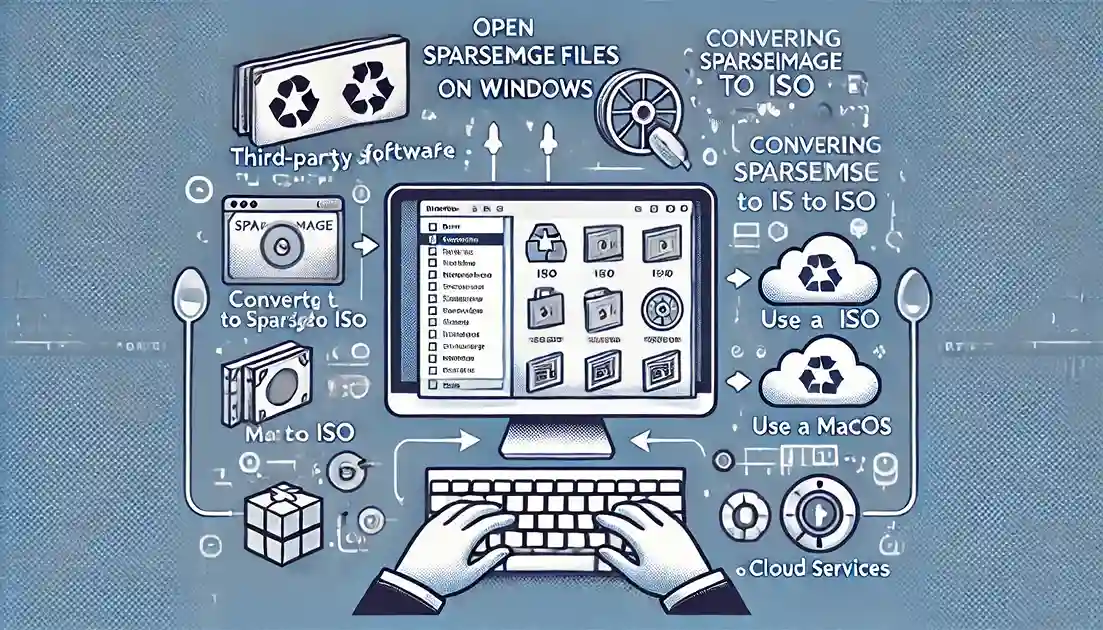In the world of digital storage, you will often see a file with the .sparseimage extension as a macOS user; this is an Apple OS-specific disk image format. They are files with flexibility because they increase and decrease in size as more content is added or removed. It may not be very clear how to open or interact with the Sparse image file when a Windows user gets one. This guide seeks to demystify the procedure and offers you all the enlightenment you need to open Sparseimage files over a Windows OS.
Whether you’re switching between macOS and Windows, sharing a file with someone using a different OS, or simply need access to the data stored within a Sparseimage file, this is the guide for you. From understanding what Sparseimage files are to a step-by-step guide on How to Open Sparseimage Windows, we have you covered.
1. What is a Sparseimage File?
![]()
A Sparseimage file is a type of disk image used primarily on macOS. Unlike a regular disk image, which is a fixed-size container, a Sparseimage file is dynamic, meaning it grows and shrinks based on the amount of data it contains. This flexibility makes it a popular choice for backing up files or creating secure, encrypted containers on macOS.
Sparseimage files can be encrypted, providing an additional layer of security for sensitive data. They are often used in applications like Disk Utility or Time Machine for backup purposes. However, because they are native to macOS, Windows users often find themselves at a loss when they need to open or use these files. To solve this problem, understanding How to Open Sparseimage Windows is crucial for those needing cross-platform access to their data.
2. Why You Might Need to Open Sparseimage Files on Windows
There are several scenarios where a Windows user might need to open a Sparseimage file:
- File Sharing: If you’ve received a Sparseimage file from a colleague or friend who uses macOS, you’ll need to open it on your Windows machine.
- Backup Access: If you’ve transitioned from macOS to Windows but need to access old backups or data stored in Sparseimage format.
- Cross-Platform Workflows: In a mixed environment where both macOS and Windows systems are used, accessing Sparseimage files on Windows might be necessary for seamless workflow continuity.
Check out our latest guide on Ear Plugs to gain deeper insights and optimize your workflow effectively.
3. Challenges of Opening Sparseimage Files on Windows
Opening a Sparseimage file on Windows isn’t straightforward because Windows does not natively support the format. The primary challenges include:
- Lack of Native Support: Windows Explorer doesn’t recognize Sparseimage files, so you can’t just double-click to open them as you would on macOS.
- Encryption Issues: If the Sparseimage file is encrypted, you’ll need to decrypt it using a compatible tool before accessing the contents.
- Data Integrity: Converting or opening Sparseimage files incorrectly might result in data corruption or loss.
4. Methods to Open Sparseimage Files on Windows
There are several methods to How to Open Sparseimage Windows files, each with its own set of advantages and limitations. Below, we outline the most effective methods:

a. Using Third-Party Software
Several third-party applications are available that can open or convert Sparseimage files on Windows. Some popular options include HFSExplorer, TransMac, and PowerISO.
b. Converting Sparseimage to ISO
Converting a Sparseimage file to an ISO format makes it easier to mount and open on Windows. This method is a key step in understanding How to Open Sparseimage Windows and involves using macOS to perform the conversion or utilizing specialized software.
c. Using a macOS Virtual Machine
Running macOS on a virtual machine (VM) within your Windows system allows you to open and interact with Sparseimage files as if you were using a native Mac environment.
d. Utilizing Cloud Services
Another method is to upload the Sparseimage file to a cloud service that can handle macOS disk images, allowing you to access the contents without directly converting or opening the file on your local machine.
5. Detailed Steps for Each Method
Step-by-Step Guide: Using Third-Party Software
- Download and Install the Software: Choose a reliable third-party tool such as HFSExplorer or TransMac. Download and install it on your Windows system.
- Open the Sparseimage File: Launch the software and use the file explorer within the application to locate and open the Sparseimage file.
- Access the Contents: Once opened, you can browse, extract, or copy the contents of the Sparseimage file to your Windows system.
Converting Sparseimage to ISO
- Access macOS (if available): If you have access to a macOS system, open Disk Utility.
- Convert the File: In Disk Utility, select the Sparseimage file and choose the option to convert it to an ISO format.
- Transfer to Windows: Once converted, transfer the ISO file to your Windows machine.
- Mount the ISO: On Windows, right-click the ISO file and select ‘Mount’. You can now access the contents as if it were a regular drive.
Using a macOS Virtual Machine
- Set Up the Virtual Machine: Install a macOS virtual machine using software like VirtualBox or VMware.
- Open the Sparseimage File: Once the VM is running, use Finder to locate and open the Sparseimage file.
- Access or Transfer Files: You can either work within the VM or transfer files from the VM to your Windows system.
Utilizing Cloud Services
- Upload the Sparseimage File: Use a cloud service that supports macOS disk images, like Google Drive or Dropbox.
- Access via Browser: Use the cloud service’s web interface to access and download the contents of the Sparseimage file directly to your Windows machine.
6. Pros and Cons of Each Method
Using Third-Party Software
- Pros: Easy to use, direct access to files.
- Cons: Limited features in free versions, potential compatibility issues.
Converting Sparseimage to ISO
- Pros: Simple if macOS is available, widely supported ISO format.
- Cons: Requires macOS access, can be time-consuming.
Using a macOS Virtual Machine
- Pros: Full macOS environment, can handle complex Sparseimage files.
- Cons: Requires significant system resources, technical setup.
Utilizing Cloud Services
- Pros: No local software needed, easy to share files.
- Cons: Depends on internet speed, privacy concerns with sensitive data.
7. Tips for Managing Sparseimage Files Across Platforms
- Regular Backups: Always keep backups of your Sparseimage files before attempting any conversions or opening them on Windows.
- Use Compatible File Formats: When possible, use file formats like ISO or VHD that are natively supported by both macOS and Windows.
- Keep Software Updated: Ensure that any third-party software used for opening Sparseimage files is up-to-date to avoid compatibility issues.
8. Alternative Solutions for Cross-Platform Disk Image Handling
If you frequently need to understand How to Open Sparseimage Windows files across platforms, consider using cross-platform tools or file formats that are universally supported, such as ISO or ZIP files. Additionally, cloud-based file management systems can offer a seamless way to access and share files across different operating systems without the need for local software.
9. Frequently Asked Questions (FAQs)
Q: Can I open a Sparseimage file on Windows without converting it?
A: Yes, using third-party software like HFSExplorer or TransMac can allow you to open Sparseimage files directly on Windows.
Q: What happens if my Sparseimage file is encrypted?
A: If the file is encrypted, you will need the correct password to decrypt it. Some third-party tools can handle encryption, but it may be easier to decrypt the file on a macOS system before transferring it to Windows.
Q: Is there a risk of data loss when converting Sparseimage files?
A: While rare, there is always a slight risk of data corruption when converting files. To mitigate this, ensure you have backups before attempting any conversion.
Conclusion (How to Open Sparseimage Windows)
Opening Sparseimage files on Windows can seem daunting at first, but with the right tools and knowledge, it’s entirely possible. Whether you choose to use third-party software, convert the file to an ISO, or even run a macOS virtual machine, each method has its own set of benefits tailored to different needs. Discover more valuable insights and tools by visiting our MyTechAngle and explore all that we offer!
Remember, the best approach depends on your specific situation, including how frequently you need to access Sparseimage files and your technical comfort level. By following the steps outlined in this guide on How to Open Sparseimage Windows, you can easily access and manage Sparseimage files on Windows, ensuring that your data is always within reach, no matter which operating system you’re using.


